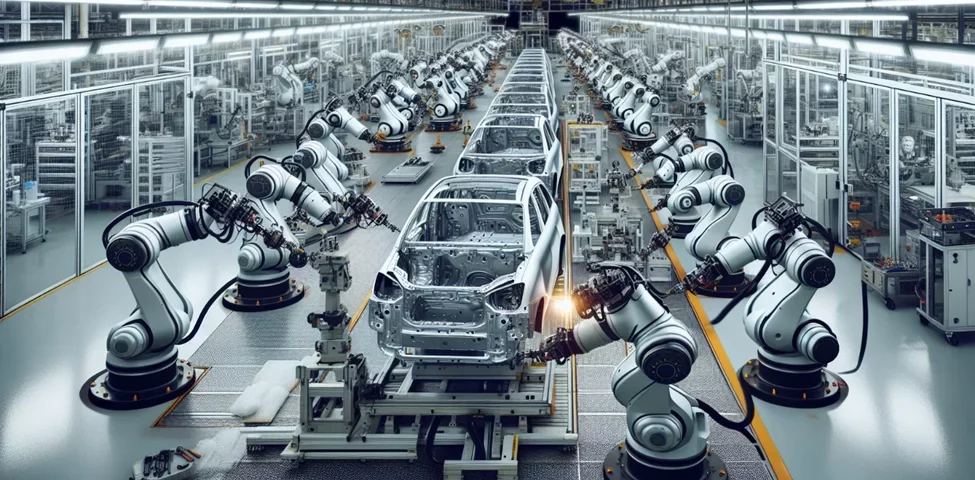Imagine a world where repetitive tasks vanish, replaced by machines that work tirelessly and flawlessly. This isn’t science fiction – it’s the reality of programmable automation.
Programmable automation, also known as industrial automation, harnesses the power of programmable logic controllers (PLCs) and robots to automate tasks across industries. Imagine an assembly line in a car factory – robots weld parts together with precision, guided by programs that dictate every movement.

Programmable automation allows for machine configurations and operation sequences that can change based on signals sent from electronic controls. With a programmable automation system, products can be produced in batches through the reprogramming of machine operations and sequences. The products created in this process typically are batch quantities, and these batches can be as low as just a few dozen products and as high as thousands of units produced at a time.
Whenever a new product batch is required, the programmable automation equipment can be changed and reprogrammed to handle the new and different product types. The automated production line process cannot continue while the reprogramming and changeover processes are occurring. After these changes, the production of a new type of batch runs.

Beyond the Factory Floor: Applications Abound
Programmable automation isn’t limited to manufacturing. Its applications extend to various sectors, including:
- Logistics and Warehousing: Automated robots can efficiently pick and pack goods, improve inventory management, and optimize warehouse layouts.
- Agriculture: Programmable irrigation systems adjust water flow based on weather conditions, while autonomous tractors plow fields and harvest crops, increasing yield and efficiency.
- Healthcare: Robots can assist in surgery with incredible precision, handle medication dispensing, and even perform routine laboratory tasks.
- Electric Energy[SK1] : Programmable systems can monitor and manage power grids, optimizing energy distribution and reducing waste.
- Retail: Instead of waiting in line with a cashier, you can use machines to scan your groceries and pay for them yourself. These machines make checkout faster.
These are just a few examples, and as technology advances, the possibilities for programmable automation are truly limitless.
The Benefits of Embracing Automation

There’s a reason why programmable automation has taken the world by storm. Here are some of the key benefits it offers:
- Increased Efficiency: Automation eliminates human error and reduces the time needed to complete tasks. This leads to higher productivity and faster turnaround times.
- Improved Quality: Robots and automated systems can perform tasks with consistent and precise accuracy, resulting in fewer defects and higher quality products.
- Enhanced Safety: Programmable automation can take on dangerous tasks, such as welding or handling hazardous materials, keeping workers safe.
- Reduced Costs: Automation can significantly reduce labor costs, eliminate waste, and optimize resource use, leading to significant cost savings.
- Scalability: Programmable systems can be easily scaled up or down to meet changing production demands.
- Data-Driven Decision Making: Automation systems can collect and analyze data throughout the process, providing valuable insights that improve operations and decision-making.
The Future of Work: A Collaborative Approach
While there are concerns about automation replacing human jobs, the reality is that programmable automation will likely create new opportunities. As repetitive tasks are automated, human workers will be required to focus on higher-level skills like:
- Programming and system maintenance: Programming skills will be crucial for designing, implementing, and maintaining automated systems.
- Data analysis and interpretation: The ability to analyze data generated by automation systems and use it to make informed decisions will become increasingly important.
- Creativity and innovation: Human creativity will be crucial for developing new applications for automation and creating solutions to complex problems that can’t be automated.
The future of work will likely be a collaborative one, with humans and machines working together to achieve optimal results.
Getting Started with Programmable Automation
If you’re considering implementing programmable automation in your business, here are some steps to get you started:
- Identify tasks: Analyze your current processes and identify tasks that are repetitive, time-consuming, or hazardous. These are prime candidates for automation.
- Cost-benefit analysis: Conduct a thorough cost-benefit analysis to evaluate the financial feasibility of implementing automation.
- Choose the right technology: There’s a wide range of automation solutions available. Research and select the technology that best suits your needs and budget.
- Invest in training: Ensure your workforce is equipped with the skills needed to operate and maintain the automated systems.
Transforming Businesses, Transforming Lives
Programmable automation is a powerful tool that has the potential to transform businesses and improve lives. By embracing automation, businesses can become more efficient, cost-effective, and competitive. But beyond the business benefits, automation can also lead to a safer working environment and even open doors to new scientific discoveries and medical advancements in healthcare. As technology continues to evolve, programmable automation will undoubtedly play an even greater role in shaping the future.
To read more AI & Automation blogs, visit https://werqlabs.com/blogs/

Somebody essentially lend a hand to make significantly articles Id state That is the very first time I frequented your website page and up to now I surprised with the research you made to make this actual submit amazing Wonderful task.
I don’t know where you get your knowledge, but this is a really great problem. I ought to take some time to comprehend or discover more. I appreciate the wonderful information; it was exactly what I needed for my purpose.
I am often to blogging and i really admire your content. The article has really peaks my interest. I am going to bookmark your web site and preserve checking for new information.
I was just as captivated by your creations as I was. The drawing you’ve created is stunning, and the writing you’ve done is sophisticated. However, your remarks indicate that you are worried about the possibility of engaging in something that may be seen as dubious. I’ll be able to resolve this quickly.